monthly tips
12–16 minute read
Our frost date is past and spring is truly here. Celebrate and learn as well by visiting local parks and botanical gardens. See how a plant looks at maturity and how it has performed over the long term.
Routine Care
fertilizing
Fertilize summer-flowering plants if needed.
mulching
To conserve moisture and suppress weeds, mulch established plants to a depth of 2 to 3 inches. New plantings should be mulched only to a depth of about 1 inch. Deeper mulch can cause drought stress. Keep mulch away from plant crowns because trapped moisture can promote rot and disease.
Find the best mulch for your situation
How to apply mulch
tidying
- Remove spent flowers from spring-flowering bulbs, but leave the foliage to replenish the bulb for next year. Don’t braid, tie or otherwise damage the leaves, just let them die down naturally. Plant annuals and perennials like hostas among the bulbs to help disguise unsightly foliage.
- Stake floppy plants such as peonies and dahlias while small. When larger, they can be injured by staking and tying.
watering
Most plants need 1–1.25 inches of water per week. Because hard downpours can run off without soaking in, plants can need water even after a 3-inch rainfall.
In a drought, use longevity as a guide: water trees first, then shrubs, then perennials.
Special tasks
planting & Propagating
- Plant summer annuals like begonia, geranium, marigold, petunia, and zinnia.
- Plant summer-flowering bulbs like gladiolus (actually corms), canna, calla, dahlia, caladium, and elephant ears.
- Plant and transplant hostas and baptisias. Bob Solberg finds that planting hostas after the first flush of leaves has hardened off is best for spring planting/transplanting. There are two reasons: 1) Leaves are less susceptible to dessication and 2) this is when hosta roots begin growing, so they recover from damage quickly. Similarly, baptisias put out new roots post-bloom. If transplanting, do so carefully, trying to preserve the tap root.
- Take softwood cuttings of plants like azalea, rhododendron, forsythia, clematis, chrysanthemum, and geranium in late May.
pruning
| Jan | Feb | Mar | Apr | May | Jun | Jul | Aug | ||||||||||
|---|---|---|---|---|---|---|---|---|---|---|---|---|---|---|---|---|---|
| TREES | |||||||||||||||||
| shade | |||||||||||||||||
| bleeder | small branches | ||||||||||||||||
| fruit | |||||||||||||||||
| SHRUBS | |||||||||||||||||
| summer-blooming | after bloom | ||||||||||||||||
| spring-blooming | after bloom | ||||||||||||||||
| broadleaf EG | dieback | ||||||||||||||||
| needle EG | |||||||||||||||||
| HERBACEOUS | |||||||||||||||||
| grasses | |||||||||||||||||
| flowers | pinch, deadhead | ||||||||||||||||
- If needed, prune spring-flowering shrubs soon after they finish blooming. Because flower buds for next year arise from growth that occurs this year, pruning now avoids sacrificing any flowers. Young shrubs may not require pruning.
- When cutting roses for the house or removing spent blooms, choose a 5-leaf leaflet that points away from the center of the bush. Cut at a 45-degree angle so that the selected leaflet is ¼ inch below the upper end of the slope. The American Rose Society recommends selecting a leaflet near the top of the cane for the first round of deadheading and farther down for subsequent trimmings.
- Pinch back mums, zinnia, salvia, cockscomb (celosia), petunias, marigolds, snapdragons and garden phlox using your index finger and thumbnail to break out the lead growth at tips of branches. Continue pinching mums through early July. Pinching also works well for many vegetable plants, including tomatoes and peppers. Pinched plants have shorter, sturdier stems, more lateral branching and more blooms.
soil Test
It is a good idea to test your soil every 2–3 years so that you can adjust pH and fertilize more accurately. Testing is free from April–November. You can pick up and drop off soil boxes, forms, and sampling instructions 8am–5pm M–F in the lobby of the Extension Office: Bonnie B Davis Center, 1020 US-70W.
Learn more about soil testing
problems
disease
Be proactive about fungal disease. The best approach is to purchase genetically resistant cultivars. Otherwise, think of fungicides as vaccines that prevent diseases rather than curing them: apply when conditions favor disease development but before symptoms appear.
Minimize dogwood diseases. Keep them watered, maintain soil fertility and clean up leaf litter to reduce disease pressure. When purchasing a flowering dogwood (Cornus florida), seek out disease-resistant cultivars like ‘Cherokee Brave’ (pink bloom, partial resistance), ‘Jean’s Appalachian Snow’ (white bloom, high resistance), or ‘Kay’s Appalachian Mist’ (white bloom, high resistance). Alternatively, plant a Kousa dogwood (complete resistance) or a florida-kousa hybrid from the Rutgers ‘Constellation’ series (moderate resistance).
Monitor azaleas and camellias for leaf galls (white, fleshy growths) and pick them off as they form.
Monitor roses for diseases and insects. If you plan to spray, begin as soon as the first leaves appear.
pests
Beneficial insects share the same plants as insect pests. To protect beneficials, use low-toxicity pesticides when possible, spray only if needed and spray at dusk when pollinators are no longer active. Always read and follow label directions for safe pesticide application.
Click on a pest name in the pest calendar below to learn more.
| Jan | Feb | Mar | Apr | May | Jun | Jul | Aug | Sep | Oct | Nov | Dec |
|---|---|---|---|---|---|---|---|---|---|---|---|
| Emerald ash borer | |||||||||||
| tent caterpillar | |||||||||||
| black vine weevil | |||||||||||
| spider mites | |||||||||||
| scales, slugs | |||||||||||
| aphids, lace bugs | |||||||||||
| bagworm | pick bags | ||||||||||
| boxwood leaf miner | |||||||||||
| ironweed longhorn borer | |||||||||||
| flatid planthopper Japanese beetle CATERPILLARS: genista broom moth silvery checkerspot fall webworm | |||||||||||
| twospotted spider mite kudzu bug | |||||||||||
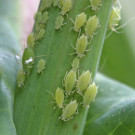 Aphids are usually green but can be many other colors. They attack tender new plant growth. Fortunately, they can be washed off with a forceful stream of water. Severe infestations can be controlled with the relatively environmentally benign insecticidal soaps.
Aphids are usually green but can be many other colors. They attack tender new plant growth. Fortunately, they can be washed off with a forceful stream of water. Severe infestations can be controlled with the relatively environmentally benign insecticidal soaps.
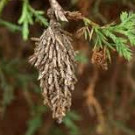 Bagworms can be controlled by hand-removing the bags before adults emerge in August–September (sprays cannot penetrated the bags) and during the fall, winter and spring, before the eggs hatch in May. Use a sharp knife/utility razor to cut the silk wrapped around the twig to prevent later girdling. Conifers like Conifers like arborvitae, cedar, juniper and pine sustain the most damage, but caterpillars also feed on many deciduous species such as willow, maple, locust, sycamore and elm. Scout buildings as well because often the bags are attached to siding.
Bagworms can be controlled by hand-removing the bags before adults emerge in August–September (sprays cannot penetrated the bags) and during the fall, winter and spring, before the eggs hatch in May. Use a sharp knife/utility razor to cut the silk wrapped around the twig to prevent later girdling. Conifers like Conifers like arborvitae, cedar, juniper and pine sustain the most damage, but caterpillars also feed on many deciduous species such as willow, maple, locust, sycamore and elm. Scout buildings as well because often the bags are attached to siding.
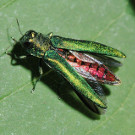 Emerald ash borers have been confirmed in Orange County. They attack all species of native ash as well as our native white fringetree. The top of the crown begins to thin and partially die (sprouting from the main stem of the tree may also occur), followed by death within 2–5 years. While the borers spread a few miles per year by flight, the main route of spread is from contaminated firewood. Interstate movement of EAB-host wood and wood products is prohibited for all of NC. However, movement within our state is not. Please be cautious when purchasing or accepting firewood, wood chips, etc. if you suspect that your trees are infected, please report the location and descriptions of potentially infested trees to 800-206-9333 or newpest@ncagr.gov.
Emerald ash borers have been confirmed in Orange County. They attack all species of native ash as well as our native white fringetree. The top of the crown begins to thin and partially die (sprouting from the main stem of the tree may also occur), followed by death within 2–5 years. While the borers spread a few miles per year by flight, the main route of spread is from contaminated firewood. Interstate movement of EAB-host wood and wood products is prohibited for all of NC. However, movement within our state is not. Please be cautious when purchasing or accepting firewood, wood chips, etc. if you suspect that your trees are infected, please report the location and descriptions of potentially infested trees to 800-206-9333 or newpest@ncagr.gov.
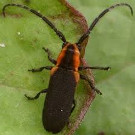 Ironweed longhorn borers attack many species in addition to ironweed, including coneflowers (purple coneflowers, sunflowers, heliopsis, etc.), bloodwort, verbesina, turtleheads, fall-blooming anemones, and even shrubs like beautyberries. The beetle creates a series of wounds in which eggs are laid, then girdles the stem below the egg holes. Cut off the wilted stem below the lowest wound and dispose — don’t compost — so that larvae cannot mature.
Ironweed longhorn borers attack many species in addition to ironweed, including coneflowers (purple coneflowers, sunflowers, heliopsis, etc.), bloodwort, verbesina, turtleheads, fall-blooming anemones, and even shrubs like beautyberries. The beetle creates a series of wounds in which eggs are laid, then girdles the stem below the egg holes. Cut off the wilted stem below the lowest wound and dispose — don’t compost — so that larvae cannot mature.
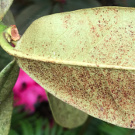 Lace bugs can attack new growth, usually only on azalea/rhododendron, but sometimes on pyracantha, cotoneaster, quince or hawthorne. Dark spots about the size of a pinhead on the lower leaf surface are diagnostic. The best defense is to plant genetically resistant varieties and to maintain plant vigor. For control of severe infestations where there is no evidence that natural predators are present, repeated applications of insecticidal soap or horticultural oil can be effective. When a history of lace bug infestation exists, insecticides can be applied to the lower leaf surface, usually two applications approximately two weeks apart. Monitor the plants about once a month for reinfestations.
Lace bugs can attack new growth, usually only on azalea/rhododendron, but sometimes on pyracantha, cotoneaster, quince or hawthorne. Dark spots about the size of a pinhead on the lower leaf surface are diagnostic. The best defense is to plant genetically resistant varieties and to maintain plant vigor. For control of severe infestations where there is no evidence that natural predators are present, repeated applications of insecticidal soap or horticultural oil can be effective. When a history of lace bug infestation exists, insecticides can be applied to the lower leaf surface, usually two applications approximately two weeks apart. Monitor the plants about once a month for reinfestations.
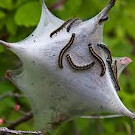 Eastern tent caterpillars often attack young cherries or sourwoods or plants in poor health. Physical removal is an effective strategy — most will be in the tent on a rainy day or at dawn or dusk.
Eastern tent caterpillars often attack young cherries or sourwoods or plants in poor health. Physical removal is an effective strategy — most will be in the tent on a rainy day or at dawn or dusk.
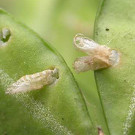 Boxwood leafminers feed inside the leaf, causing blisters on the underside. American boxwood varieties are more susceptible. Prune the foliage in May before adults emerge or right after adult flies lay their eggs. If insecticide is needed, apply when new leaves are fully formed (Weigela bloom is a good indicator of timing), then once more between mid-June and mid-July.
Boxwood leafminers feed inside the leaf, causing blisters on the underside. American boxwood varieties are more susceptible. Prune the foliage in May before adults emerge or right after adult flies lay their eggs. If insecticide is needed, apply when new leaves are fully formed (Weigela bloom is a good indicator of timing), then once more between mid-June and mid-July.
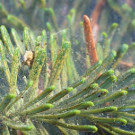 Cool season spider mites can attack many species. Southern red mites prefer broad-leafed evergreens, while spruce mites prefer conifers. They are active in the cooler months, usually during prolonged periods of high humidity. Hold a piece of white paper under a stem and vigorously shake the foliage. Ignore anything that moves quickly. Watch for specks smaller than a period to begin moving. Damage (interior browning of foliage) is not seen until early summer, when the mites are no longer present.
Cool season spider mites can attack many species. Southern red mites prefer broad-leafed evergreens, while spruce mites prefer conifers. They are active in the cooler months, usually during prolonged periods of high humidity. Hold a piece of white paper under a stem and vigorously shake the foliage. Ignore anything that moves quickly. Watch for specks smaller than a period to begin moving. Damage (interior browning of foliage) is not seen until early summer, when the mites are no longer present.
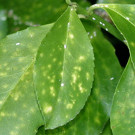 Scales are divided into two groups, armored and soft, based on their coverings. Armored scales usually have several generations a year, can kill woody plants and must be controlled when numerous. Soft scales have a single generation yearly, reduce plant vigor and can lead to unsightly sooty mold, but do not usually kill plants. Often, scale is controlled by beneficial predators. If necessary, try one of the following: 1) Prune out heavily infested shoots/branches 2) On deciduous species, apply horticultural oils or soaps, which will kill all scale stages. 3) Use a registered insecticide to kill crawlers. Monitor for crawlers (tiny, pale yellow specks) by using double-sided sticky tape on several branches.
Scales are divided into two groups, armored and soft, based on their coverings. Armored scales usually have several generations a year, can kill woody plants and must be controlled when numerous. Soft scales have a single generation yearly, reduce plant vigor and can lead to unsightly sooty mold, but do not usually kill plants. Often, scale is controlled by beneficial predators. If necessary, try one of the following: 1) Prune out heavily infested shoots/branches 2) On deciduous species, apply horticultural oils or soaps, which will kill all scale stages. 3) Use a registered insecticide to kill crawlers. Monitor for crawlers (tiny, pale yellow specks) by using double-sided sticky tape on several branches.
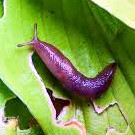 Slugs can attack soft new growth. Holes in leaves or on leaf margins and a silvery slime trail in the morning indicate slug damage. Because slugs hide under boards, stones or debris during the day, populations can be reduced by managing habitat and trapping. Alternative approaches are either ineffective (barriers like diatomaceous earth or copper) or toxic (metaldehyde baits are toxic to pets/children; iron phosphate baits containing EDTA have been found to be toxic to earthworms). To trap, try laying a board near the target plants. Lift at midday and remove the slugs clinging on the bottom.
Slugs can attack soft new growth. Holes in leaves or on leaf margins and a silvery slime trail in the morning indicate slug damage. Because slugs hide under boards, stones or debris during the day, populations can be reduced by managing habitat and trapping. Alternative approaches are either ineffective (barriers like diatomaceous earth or copper) or toxic (metaldehyde baits are toxic to pets/children; iron phosphate baits containing EDTA have been found to be toxic to earthworms). To trap, try laying a board near the target plants. Lift at midday and remove the slugs clinging on the bottom.
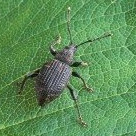 Black vine weevils are destructive to yew, hemlock, rhododendron and several other broad-leaved evergreens. To detect infestation, examine leaves for marginal notches. This cosmetic damage is the result of adults feeding at night and does not endanger the plant. However, the grubs can kill plants by feeding on roots and girdling the lower stems. Treatments targeting adults may be more effective than those for grubs in the landscape setting. See the link for details.
Black vine weevils are destructive to yew, hemlock, rhododendron and several other broad-leaved evergreens. To detect infestation, examine leaves for marginal notches. This cosmetic damage is the result of adults feeding at night and does not endanger the plant. However, the grubs can kill plants by feeding on roots and girdling the lower stems. Treatments targeting adults may be more effective than those for grubs in the landscape setting. See the link for details.
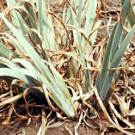 Iris problems depend on the iris type, with beardless types suited to our area being mostly trouble-free. Good sanitation in fall is sufficient for control of many problems. Monitor for healthy foliage and if you see a problem, view the link for a comprehensive list.
Iris problems depend on the iris type, with beardless types suited to our area being mostly trouble-free. Good sanitation in fall is sufficient for control of many problems. Monitor for healthy foliage and if you see a problem, view the link for a comprehensive list.
weeds
For common weeds not mentioned below, try this weed gallery. You can check for the toxicity, groundwater risk and persistance of many weed products in Toxicity of Lawn Chemicals.
- Control invasive vines and unwanted tree saplings.
- For saplings that are too large to pull, cut off close to the ground and clear away debris. Immediately paint or spray the exterior and the cut surface with a 15–25% solution of glyphosate — waiting more than 5 minutes can prevent absorption. For a larger stump, only the outer two-thirds is live wood and needs treatment.
- English ivy control differs by season. In fall, hand-pull vines and re-visit periodically to remove any residual new growth. In spring, hand-pull or use herbicide.
- Killing or removing weeds before they seed is critical for control. This is especially important for the two new ‘superweeds’ below. While both are annuals, they are extremely aggressive and produce copious seed, rapidly colonizing your yard if left unattended.
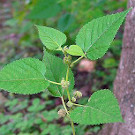 Mulberryweed (Fatoua villosa) resembles Agastache (anise hyssop), but it is easy to correctly identify by the balls of flowers in the leaf axils. A major source is contaminated potting soil from purchased plants. Because Fatoua can flower when very young, at the three-leaf stage, even tiny plants should not be ignored. A combination approach is the best strategy: removal, mulch depth of 2–3 inches, and a preemergent herbicide to suppress any seedlings that germinate.
Mulberryweed (Fatoua villosa) resembles Agastache (anise hyssop), but it is easy to correctly identify by the balls of flowers in the leaf axils. A major source is contaminated potting soil from purchased plants. Because Fatoua can flower when very young, at the three-leaf stage, even tiny plants should not be ignored. A combination approach is the best strategy: removal, mulch depth of 2–3 inches, and a preemergent herbicide to suppress any seedlings that germinate.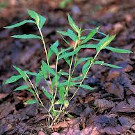 Uncut Japanese stiltgrass (Microstegium vimineum) begins to flower in late summer. It is critical to remove or kill plants before flowering because some flowers self-pollinate and produce seed before opening. Mowing lowers height but does not prevent seeding, and mulch is not an effective suppressant.
Uncut Japanese stiltgrass (Microstegium vimineum) begins to flower in late summer. It is critical to remove or kill plants before flowering because some flowers self-pollinate and produce seed before opening. Mowing lowers height but does not prevent seeding, and mulch is not an effective suppressant.
houseplants
Move houseplants outside if desired.
